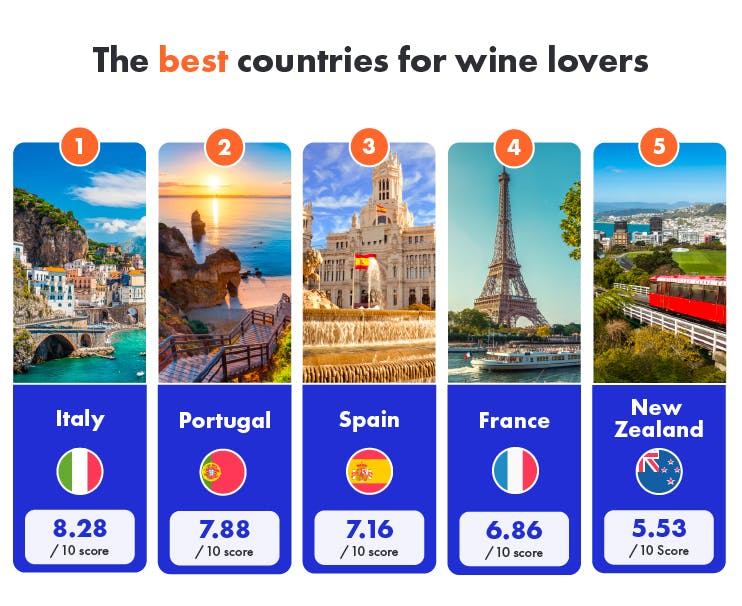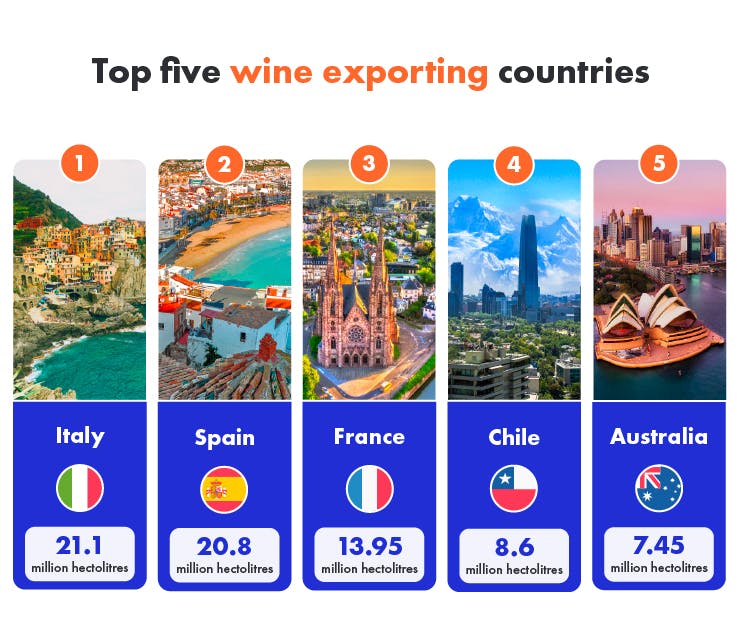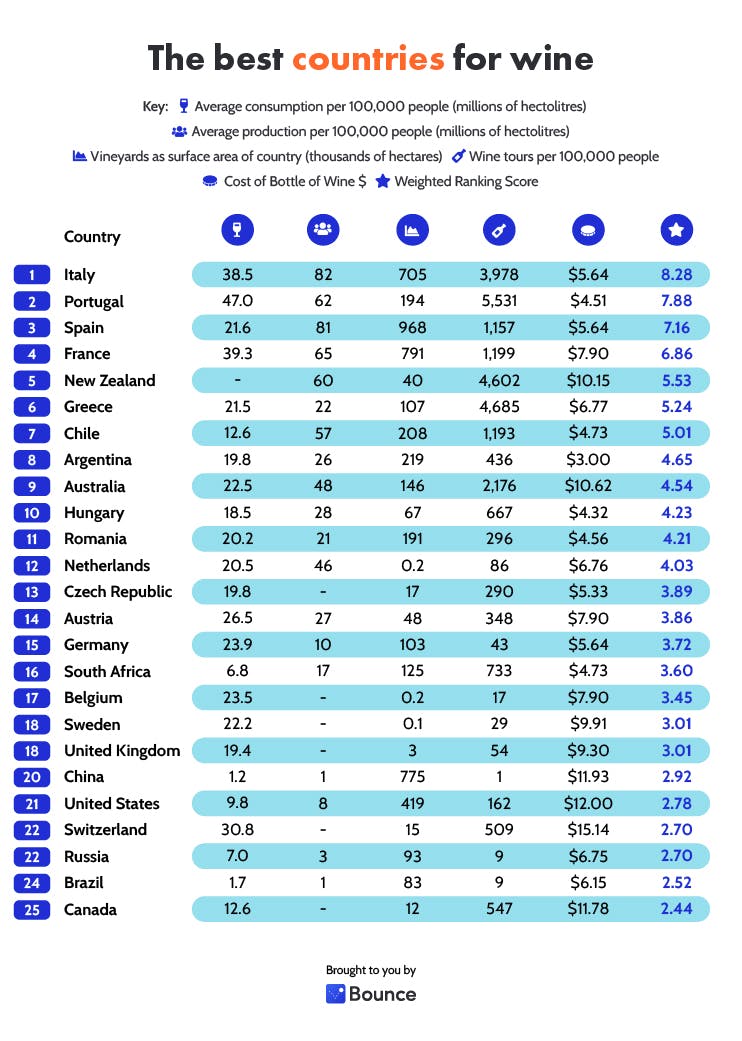The Wine Lover’s Index

Which are the best and worst countries for wine connoisseurs?
Many people love the experience of trying new things, which is especially true with wine. From vineyard tours and wine tastings to enjoying new blends created by innovative winemakers, the world of wine holds endless possibilities to explore.
Some wine-lovers take this even further, traveling the world to experience novel New World vines and natural wines, as well as classic vintages from some of the most respected vineyards in the world.
Factors such as consumption, production, exports, vineyards, wine tours, and the average cost of a bottle of wine all play a part in planning the perfect wine-lovers vacation.
Unsurprisingly these factors vary from country to country, so to reveal the best countries for wine lovers to travel to, we have ranked famous wine regions around the world on factors important to wine-loving travelers.
The best countries for wine lovers
Get $5 off with the Bounce app
Use Bounce to find nearby bag storage in 4,000+ cities worldwide.
Get the app

1. Italy: 8.28/10
Italy is home to some of the oldest wine-producing regions in the world, the most famous being Veneto, home to the cities of Venice and Verona. Italy takes the top spot in our ranking. With approximately 400 varieties of grapes native to the country, there’s a wine to suit everyone's palette. It is also the largest producer of wine in our ranking producing 0.82 litres per person.
2. Portugal: 7.88/10
This country has two wine-producing regions designated as UNESCO world heritage sites, one of which produces Portugal’s most recognized wine, Port, named after the city of Porto. This international reputation for producing unique wines could be the reason this country also has the highest number of wine tours. Portugal is also the biggest consumer of wine on our list, with the country drinking 0.47 litres per person.
3. Spain: 7.16/10
Spain is home to 12 main wine regions which produce the majority of their wines, including Cava, Rioja, and the fortified wine unique to the province of Cadiz. Spain has the highest amount of land for vineyards on our list, with 968.4 thousand hectares dedicated to viticulture. However, it ranks second in the amount of wine produced due to the arid conditions of some of its winemaking regions.
4. France: 6.86/10
France is the source of some of the most popular grape varieties for winemaking, and the home of the eponymous Burgundy, Bordeaux, and Champagne. Despite its reputation as a prestigious wine-producing country, France has relatively few wine tours, although it is still popular domestically with an average of 0.39 litres per person drunk annually.
5. New Zealand: 5.53/10
Wines from New Zealand have exploded in popularity over the last 20 years, causing their market to expand rapidly. This country is mainly known for producing Sauvignon Blanc and Pinot Noir, both originating from Marlborough, the largest wine-producing region in New Zealand. New Zealand offers 4,062 wine tours, the third-highest on our list, and has 40 thousand hectares dedicated to viniculture.

The biggest country for wine consumption
Portugal: 0.47 litres per person
This country consumes the most wine relative to the population, eight million hectolitres ahead of the closest country, France, and more than double its neighbor Spain. Cultural factors could account for this large amount of wine consumption, as many Portuguese people consider themselves everyday drinkers, consuming small amounts of wine regularly with meals.

The biggest country for wine production
Italy: 0.82 litres per person
Topping our list for this factor, Italy’s warm Mediterranean climate and fertile soils are considered perfect for growing wine grapes. Having produced wine for over 4,000 years Italian vintners have honed techniques that produce large amounts of high-quality wine.

The best country for vineyards
Spain: 968 thousand hectares
The most widely planted wine-producing nation, Spanish vineyards require a lot of space due to the spacing of the old vines to allow for ventilation to produce higher quality grapes. These vineyards also require a lot of space as a result of the low yields caused by the dry climate and arid soil of many of Spain’s wine-producing regions.

The best country for wine tours
Portugal: 55 per million people
With two of its main wine-producing regions designated UNESCO world heritage sites, it's not surprising that Portugal has the highest number of wine tours per million people. This UNESCO designation has made places such as the Douro valley, the birthplace of port, popular tourist attractions for wine lovers leading to a high number of wine tours and tastings.

The best country for the cost of a bottle of wine
Argentina: $3.00
Argentine wine is the cheapest per bottle on our list, beating the competition by $1.32. Wine in Argentina is so affordable as historically wine producers were more focused on quantity over quality resulting in high amounts of lower-quality wines with a smaller price tag.

Top five wine exporting countries
1. Italy: 21.1 million hectolitres
The largest exporter of wine on our list is Italy, with the country exporting an average of 21.1 million hectolitres. Wine exports from this country reached €6.29 billion in 2020 despite the pandemic, mainly exporting to the USA, Germany, and the UK.
2. Spain: 20.8 million hectolitres
Exporting an average of 20.8 million hectolitres, the majority of Spain’s vineyards focus on wine for export. In 2019, wine was Spain’s 4th most exported food product, behind olive oil and citrus fruits. Spain also produces a large amount of bulk wine, sold at a low price and used by other wineries to blend and bottle under their own label. This could account for their high wine exports.
3. France: 13.95 million hectolitres
Wine is the second-largest French export after the aerospace industry with producers exporting $11 billion worth of wine in 2019. However, due to the pandemic, exports fell slightly from 14.3 in 2019 to 13.6 million hectolitres in 2020. The largest overseas market for French wine is the US, accounting for a quarter of wine exports followed by the UK, Germany, and Japan.
4. Chile: 8.6 million hectolitres
Wine is Chile’s 6th biggest export with a total value of $1,826,430,000 in 2020. China is the leading destination for Chilean wine exports importing $330.8 million of wine in 2019, followed by the US with $226.75 million
5. Australia: 7.45 million hectolitres
Small vintages between 2018-2020 resulted in low inventory levels for Australian wine exporters, accounting for this country’s low export volume. Unlike the other countries on the list, Australia’s wine exports increased from 2019-2020. This was driven by exporters shipping wine to China, their main importer before tariffs were increased.

Methodology
We ranked 26 countries based on the following factors, giving each one a normalized score out of ten for each factor before taking an average across all five factors.
Wine consumption, production exports, and vineyards as surface area of the country were sourced from the OIV State of the World Vitivinicultural Sector in 2020 report.
New Zealand Vineyards surface area Wikipedia
Chile Vineyards surface area Statista
Czech Republic surface area Vina z Moravy
Country populations were sourced from The World Bank.
Cost of a bottle of wine was sourced from Numbeo.
Number of wine tours were sourced from Tripadvisor.
About Bounce
Bounce offers convenient and simple short-term bag and luggage storage to tourists, travelers, and city dwellers alike by partnering with local businesses in cities around the world. You can book your next luggage storage location via the Bounce luggage storage platform. Bounce operates more than 7,000 locations in cities around the world, including:
Get $5 off with the Bounce app
Use Bounce to find nearby bag storage in 4,000+ cities worldwide.
Get the app
